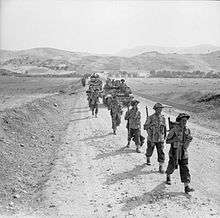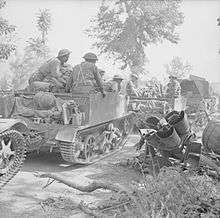38th (Irish) Brigade
| 38th (Irish) Infantry Brigade 38 (Irish) Brigade | |
|---|---|
_Brigade.jpg) Current insignia of 38 (Irish) Brigade. | |
| Active |
1942–1947 2007–present |
| Country |
|
| Branch |
|
| Type | Territorial Army |
| Size | Brigade |
| Part of |
6th Armoured Division 78th Infantry Division 1st (United Kingdom) Division |
| Garrison/HQ | Thiepval Barracks, Lisburn |
| Motto(s) | "Ubique et Semper Fidelis" |
| Commanders | |
| Notable commanders | The O'Donovan |
| Insignia | |
| Identification symbol |
 Insignia of the 78th Battleaxe Division. |
The 38 (Irish) Brigade, is an infantry brigade formation of the British Army that served in World War II. It was composed of Irish line infantry regiments and served with distinction in the Tunisian and Italian Campaigns. A similar formation, the 38th Brigade had served in World War I, but contained no Irish connection.
History
During the Second World War the 38th (Irish) Infantry Brigade came into existence on 13 January 1942 by the redesignation of the 210th Independent Infantry Brigade (Home), a Home Defence formation organised in October 1940. The 210th Brigade had been serving in Dorset County Division. When that division was disbanded on 24 November 1941, 210 Brigade transferred to the 1st Infantry Division. By then all of 210 Brigade's English home defence battalions had been posted away and were being replaced by frontline Irish battalions.[1] They were the 1st Battalion, Royal Irish Fusiliers, the 6th Battalion, Royal Inniskilling Fusiliers and the 2nd Battalion, London Irish Rifles. Of the three battalions, only the 1st Royal Irish Fusiliers had seen active service nearly two years prior, fighting in the Battle of France where they were forced to retreat to Dunkirk where they were subsequently evacuated to England. With this composition, the brigade therefore had pre-war Regular Army, Territorial Army (the British Army's part-time reserve) and war-time raised units within its structure.
In June 1942 the brigade was transferred from the 1st Infantry Division to the 6th Armoured Division and it landed in North Africa, shortly after Operation Torch, with the division on 22 November 1942, as part of the British First Army. In March 1943 it exchanged with the 1st Guards Brigade and joined the 78th Battleaxe Infantry Division and fought with distinction throughout the rest of the Tunisian Campaign. In late April the 38th Brigade played a supporting role in the capture of Longstop Hill and the campaign ended in mid-May, with almost 250,000 Axis soldiers surrendering.

After a short rest, the brigade again saw action in the Allied invasion of Sicily (in particular the capture of Centuripe), and in the Italian Campaign, spearheading the British Eighth Army's advance to the Volturno Line, at the Battle of Monte Cassino. Shortly afterwards the brigade was sent to rest in Palestine. While there the 6th Inniskillings was disbanded and the men transferred to the 2nd Battalion, another Regular Army unit, which had arrived from 13th Brigade of the 5th Division, and the surplus men were transferred to fill gaps in the other battalions of the brigade.[2]

The rest was short-lived, however, and the brigade soon returned to Italy where it was involved in the fighting around the Gothic Line, followed later by Operation Grapeshot. During May 1945, however, it was (briefly) detached to both 46th Infantry and 6th Armoured Divisions. The brigade then was allotted occupation duties in Carinthia in southern Austria, and was eventually formally disbanded in April 1947.[3][4]
Order of battle
The 38th Brigade was constituted as follows during the war:[5]
- 1st Battalion, Royal Irish Fusiliers
- 2nd Battalion, London Irish Rifles
- 6th Battalion, Royal Inniskilling Fusiliers (disbanded 5 August 1944)
- 2nd Battalion, Royal Inniskilling Fusiliers (from 26 July 1944)
Commanders
The following officers commanded the 38th Brigade during the war:[6]
- Brigadier Morgan O'Donovan (12 January 1942 – 1 July 1942)
- Brigadier Nelson Russell (1 July 1942 – 20 February 1944)
- Brigadier Thomas Scott (from 20 February 1944)
Formations served under
Formations that the brigade served under included:[7]
- 1st Infantry Division 25 November 1941 – 7 June 1942
- 6th Armoured Division 9 June 1942 – 16 February 1943
- 'Y" Division 16 Feb 43 – 15 March 1943
- 78th Infantry Division 15 March 1943 – 28 March 1943
- 46th Infantry Division 29 March 1943 – 6 April 1943
- 78th Infantry Division 7 April 1943 – 10 May 1945
- 6th Armoured Division 10 May 1945 – 13 May 1945
- 46th Infantry Division 13 May 1945 – 18 May 1945
- 78th Infantry Division 18 May 1945 – 31 August 1945
21st century
38 (Irish) Brigade reformed on 1 August 2007, as part of a new combined divisional / brigade structure called HQ Northern Ireland and 38 (Irish) Brigade after the disbandment of HQ Northern Ireland and has its Headquarters at Thiepval Barracks in Lisburn.[8]
The 38 Brigade subsequently came under command of the 2nd Division, the regional division for Scotland, the North of England and Northern Ireland, on 1 January 2009. It is now the Regional Brigade responsible for administering the Territorial Army (TA) within Northern Ireland. This was the culmination of a drawdown of military headquarters in Northern Ireland, which had seen the disbandment of 3 Infantry Brigade, 8 Infantry Brigade, 39 Infantry Brigade and 107 (Ulster) Brigade.
Today the Territorial soldiers from the brigade have served on operations supporting the Regular Army in the Balkans, on Operation TOSCA in Cyprus, on Operation HERRICK in Afghanistan and Operation TELIC in Iraq. At home the Brigade has the key role of providing the Civil Contingency Reaction Force for Northern Ireland.
Current formation
Following implementation of the Army 2020 structure the brigade currently includes the following units:[9]
- 38 (Irish) Brigade in Lisburn
- 1st Battalion, Royal Regiment of Scotland in Belfast[10]
- 2nd Battalion, The Rifles in Lisburn
- 7th Battalion, The Rifles in Reading (Army Reserve - paired with 2nd Battalion, The Rifles)
Insignia
The current Brigade insignia is a green shamrock on a circular, sand-coloured, background. This insignia was adopted to differentiate it from the Second World War design which is now too similar to the design of the tactical recognition flash (TRF) worn by the Royal Irish Regiment
References
- ↑ Joslen, p. 373.
- ↑ Ford pp. 242-243
- ↑ The Irish Brigade
- ↑ Joslen, p. 373.
- ↑ Joslen, p. 373.
- ↑ Joslen, p. 373.
- ↑ "38 (Irish) Infantry Brigade". Orders of Battle.com.
- ↑ Hansard, proceedings of the British Parliament
- ↑ "Army 2020 Report" (PDF). Retrieved 15 August 2015.
- ↑ The Red Hackle November 2012 Archived 7 May 2014 at the Wayback Machine.
Bibliography
- Ford, Ken (2003) [1999]. Battleaxe Division. Stroud, UK: Sutton Publishing. p. 273 pages. ISBN 0-7509-3199-X.
- Doherty, Richard (1994) [1993]. Clear The Way! History of the 38th (Irish) Brigade. Dublin, Ireland: Irish Academic Press. p. 336 pages. ISBN 0-7165-2542-9.
- O'Sullivan, Edmund (2007) [2007]. All My Brothers. Slough, UK: Edmund O'Sullivan & Family. p. 232 Contains an eyewitness account of serving in the 2nd Battalion of the London Irish Rifles from October 1939 March 1946 including O'Sullivan's involvement in Irish Brigade battles in Tunisia, Sicily and Italy, including at the Battle of Cassino in May 1944.
- Joslen, Lt-Col H.F. (2003) [1960]. Orders of Battle: Second World War, 1939–1945. Uckfield: Naval and Military Press. ISBN 978-1-84342-474-1.
External links
- 38 (Irish) Brigade – on British Army official website
- The Long, Long Trail
- 204 (North Irish) Field Hospital (Volunteers)
- 69 Signal Squadron (Volunteers)
- 243 Provost Company (Volunteers)
- Irish Brigade The Story of the 38th (Irish) Brigade during the Second World A website containing information and eyewitness accounts. The site also has , the story of the Irish Brigade written by TPD Scott, who commanded the brigade from February 1944 until the end of the war.